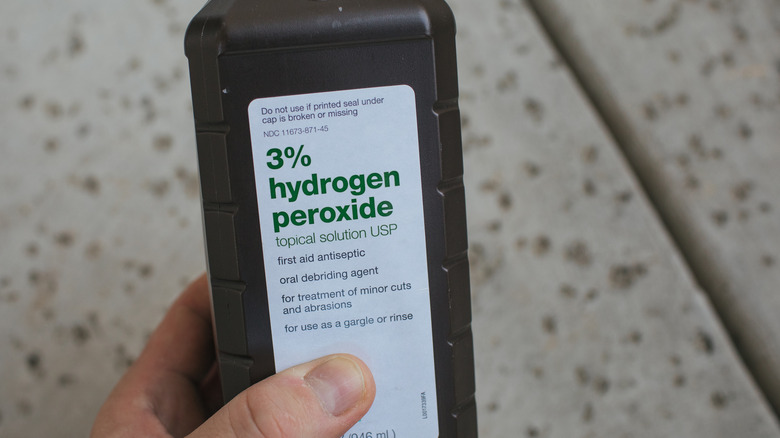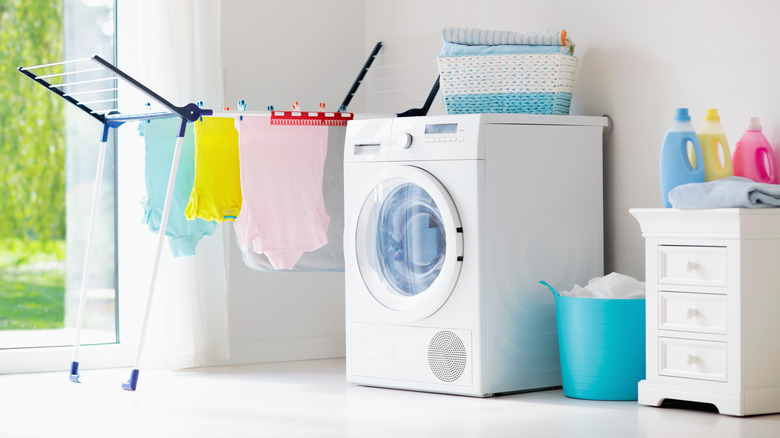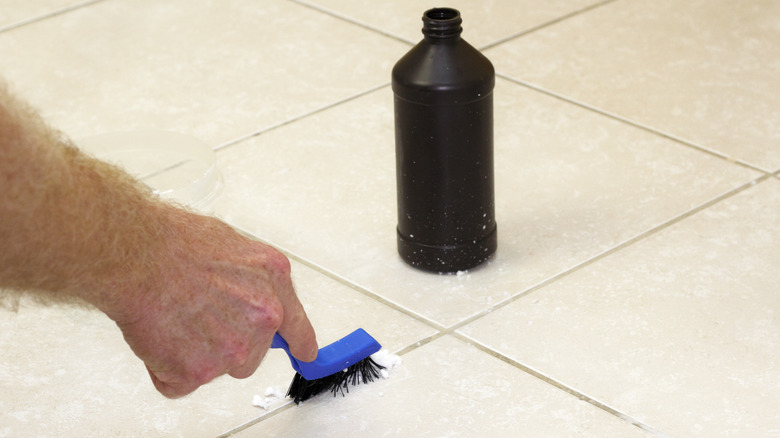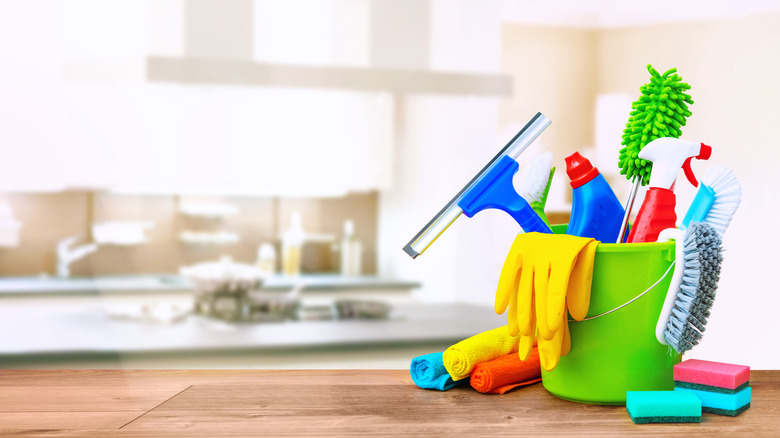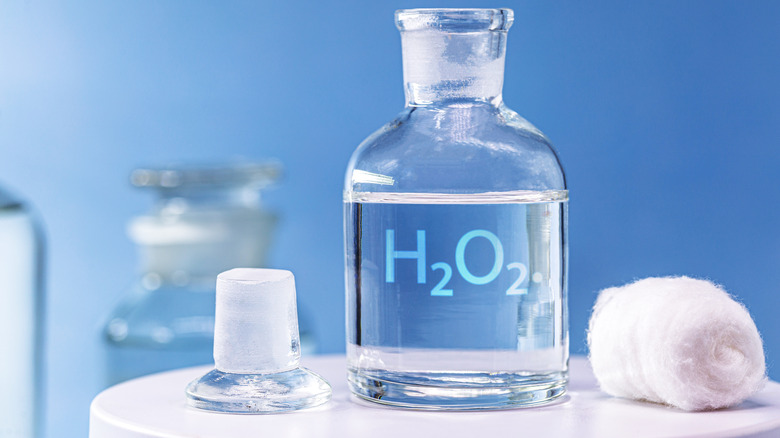The Biggest Mistakes You're Making When Cleaning With Hydrogen Peroxide
There are many different home cleaning agents you can likely find stored away in your house, including the more popular vinegar and baking soda, in addition to less-common products such as cornstarch and hydrogen peroxide. Most people limit the use of hydrogen peroxide to first aid purposes, such as cleaning cuts and preventing infection. However, according to Hello Homestead, it has many other practical uses, including getting rid of harmful bacteria on the surfaces of your home, killing mold and mildew, and removing tough stains in laundry. This chemical compound is generally sold as a liquid and can be found in the first aid section of grocery stores and pharmacies.
The best part about hydrogen peroxide is that it's perfectly safe to use around kids, pets, and food. It is similar to bleach in the way it disinfects yet not nearly as harmful, as per Healthline. Whether you have already incorporated hydrogen peroxide into your cleaning routine or are looking for ways to do so, take a peek at the following mistakes people make when using this product in their daily housekeeping tasks.
Not using hydrogen peroxide in the laundry room
If you haven't been using hydrogen peroxide in your laundry room to treat stains and brighten your whites, this is the first mistake you're making. Hydrogen peroxide is incredibly potent at getting rid of some of those set-in stains, especially from plant and protein sources, as per The Spruce. The chemical make up of this product works similarly to bleach in the way it tackles stains but without the potential to damage your clothes and linens. However, it's always important to test the reaction of the hydrogen peroxide on any colored fabrics you own to make sure no bleeding of color takes place. The best way to treat stains on your clothing is to soak a cotton ball in hydrogen peroxide and pat it onto the affected area. Alternatively, you can pour the liquid straight onto the stain and let it sit for several minutes. You can wash as per your typical routine after that.
In the same way you would use bleach in your wash cycle to brighten white clothing, linens, and towels, you can do the same with hydrogen peroxide. The good news is that hydrogen peroxide isn't dangerous to the environment or the respiratory system when inhaled. Better Home & Gardens recommends adding 1 cup of hydrogen peroxide to a machine full of whites for an extra shine when they come out.
Not using hydrogen peroxide to clean your grout
When it comes to cleaning the grout in your tiled floors or bathroom, hydrogen peroxide many not be the product that first comes to mind. However, it should as it is non-toxic and serves to clean stains on this overlooked part of your tiled floors and surfaces. The chemical compound coupled with baking soda and dish soap is the perfect combination for getting rid of that scum and grime that gets stuck in grout while also removing mildew and disinfecting the surface area, as per Bob Vila. The website recommends mixing 1/2 cup of baking soda and 1/4 cup of hydrogen peroxide in a bowl or bottle to use as the main grime-fighting product. 1 teaspoon of dish soap gives the mixture an extra kick. This tried and true combo will cut through the stuck-on dirt and brighten the white of the grout.
You'll want to spread the mixture along the grout lines and let it sit for several minutes before wiping it away. You likely won't need a brush to scrub the grout unless the area is exceptionally dirty. In the case of needing to scrub, repeat the process of applying the product, scrubbing the grout, and wiping the residue away until the grout is clean enough to your standards. Splashing the area with water afterwards will ensure complete removal of the cleaning product.
Mixing hydrogen peroxide with other cleaning agents
One of the biggest no-nos when it comes to incorporating hydrogen peroxide into your house cleaning arsenal is to mix it with certain other chemical compounds, such as vinegar. Doing so creates a dangerous compound known as peracetic acid, which is highly corrosive, as per Kitchn. This acid can damage the sensitive areas around your eyes and nose when it comes into contact with your skin and can also harm your respiratory system when inhaled. If you come across cleaning tips that incorporate both vinegar and hydrogen peroxide, note that this means the two products are both being used to clean a specific surface but are never mixed directly together. You should let one product dry completely before following up with the other.
Another potentially fatal combo is mixing hydrogen peroxide with bleach, according to Chemical & Engineering News. The result of mixing these two compounds is the release of oxygen gas, which is highly flammable and can cause an incredibly dangerous explosion in the right environment and under specific pressures. As a general rule, make sure to always research whether hydrogen peroxide can be mixed with another cleaning chemical agent before doing so. Better yet, avoid mixing cleaning chemicals at all to truly avoid any dangerous incidents.
Not storing hydrogen peroxide properly
Did you know that the only difference between hydrogen peroxide and water is that the former has one extra oxygen molecule in its chemical make-up? This means that hydrogen peroxide can very easily decompose into plain old water, as per ReAgent. This typically happens when hydrogen peroxide isn't stored properly. It should stay in the dark-hued bottle you bought it in to avoid exposure to UV rays, which speeds up the chemical decomposition. It should also be placed in a dry and cool location in your home to avoid the harmful effects of moisture and heat on its delicate chemical balance. You'll know if your hydrogen peroxide has yet to decompose as it will fizz when you use it to clean. If it doesn't fizz, you can throw it out. You don't want to use expired hydrogen peroxide.
The bad news is that hydrogen peroxide will decompose naturally over time regardless of the steps you take to prevent it. However, you can get a good six months of use out of a single bottle of the chemical compound once opened before needing to head to the store to stock up on more. Remember to also keep your hydrogen peroxide in a location far from fire hazards. While it is technically non-flammable, it can experience spontaneous combustion when in the vicinity of flammable hazards due its oxidizing tendencies, reports Forest Products Laboratory.
Not using hydrogen peroxide as a general disinfectant
You may already know that hydrogen peroxide works wonders to disinfect cuts and scrapes, but did you know just how effective it is at sanitizing most of the surfaces and items in your home? With a bottle of hydrogen peroxide always on hand, you'll have the perfect product to tackle anything from the kitchen sink to bathroom fixtures and even your weekly produce, as per The Healthy. To avoid pouring your hydrogen peroxide out of its original, darkened bottle to use it in a spray bottle, simply screw the spritzer module onto the bottle of hydrogen peroxide itself. This will prevent it from decomposing too quickly in a normal spray bottle.
You can use your handy hydrogen peroxide spray bottle to spritz and wipe down countertops, sinks, bathtubs, toilets, and appliances — but don't stop here. Give your kids' plastic toys a bath with hydrogen peroxide to get rid of any lingering dirt and bacteria. You can also soak toothbrushes, retainers, and mouth guards in 1 cup of hydrogen peroxide for a thorough sanitization. If you want to use hydrogen peroxide to clean food, such as fruits and vegetables, make sure to purchase a special food-grade version with a low chemical concentration to avoid potential ingestion issues and make sure to rinse well. Other items that you can disinfect with hydrogen peroxide include sponges and garage cans.
